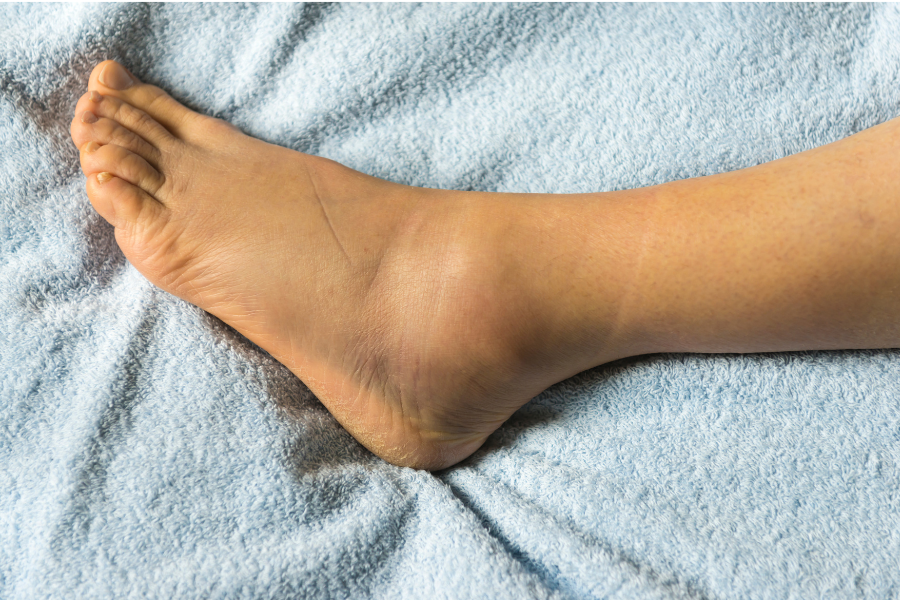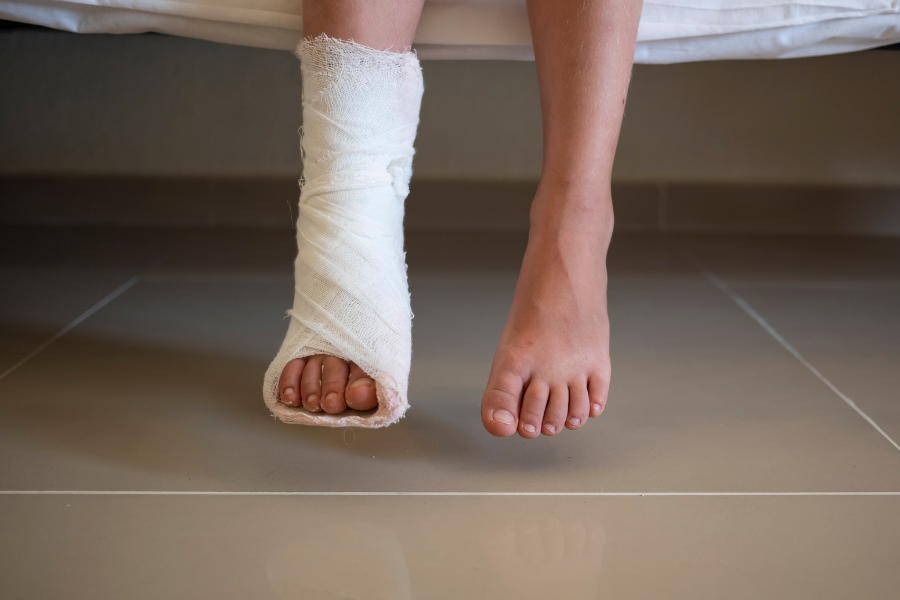 An ankle fracture is a very common injury sustained by children between the ages of 8 and 15. Whether playing “jumping” sports like basketball or engaging in any other activity that may cause a sudden twist of the ankle, fractures typically occur in one or more bones that make up the ankle: the shinbone (tibia), a smaller adjacent bone (fibula), and a small foot bone (talus) that acts as a hinge in the joint.
An ankle fracture is a very common injury sustained by children between the ages of 8 and 15. Whether playing “jumping” sports like basketball or engaging in any other activity that may cause a sudden twist of the ankle, fractures typically occur in one or more bones that make up the ankle: the shinbone (tibia), a smaller adjacent bone (fibula), and a small foot bone (talus) that acts as a hinge in the joint.
Oftentimes, these injuries affect the growth plate – cartilage tissue at the end of the tibia and fibula that produces new bone tissue as a child’s body matures. In fact, children’s ankle fractures occur at a staggering rate of 25-40% of all fractures involving the body’s growth plates.
Child’s Broken Ankle Symptoms
It is often difficult to distinguish between the symptoms of a simple sprain and more serious fracture without an X-ray. However, broken ankle fracture symptoms may include:
- Tenderness
- Bruising
- Swelling
- Deformed or crooked appearance
- Inability to bear weight
- Pain when touched or moved
- Bone exposed through the skin (in severe cases)
 Because of the nature and potential risks of the injury, it is critical to take your child to the doctor as soon as possible. While any doctor can perform an X-ray for a professional diagnosis, only a qualified orthopedic physician will be able to determine the appropriate solution – be it crutches, a splint or perhaps ankle surgery – based on the location and extent of the injury.
Because of the nature and potential risks of the injury, it is critical to take your child to the doctor as soon as possible. While any doctor can perform an X-ray for a professional diagnosis, only a qualified orthopedic physician will be able to determine the appropriate solution – be it crutches, a splint or perhaps ankle surgery – based on the location and extent of the injury.
What are the Different Tests Used to Diagnose a Broken Ankle?
There are three types of tests used to determine if an ankle is broken, fractured or injured. These tests include:
- X-rays – The most common test to determine an injury, an X-ray can provide a clear image of any bone in the body. If your child does have a broken ankle, an X-ray will typically show this injury. If the injury is a hairline fracture, an X-ray may not be the best test.
- Magnetic Resonance Imaging (MRI Scan) – If an X-ray doesn’t determine the injury, but a physical test of the ankle does suggest a fracture, your doctor will then order a MRI scan. MRI scans provide your doctor with high resolution images of both the bones and soft tissues in the ankle.
- Computed Tomography (CT Scan) – CT scans are helpful if the doctor’s physical tests suggest the fracture may extend into the ankle joint. A CT scan creates a cross-section image of the ankle.
What is the Treatment for a Broken Ankle?
There are different treatments depending on the fracture of the ankle. Your doctor may find that a walking boot or crutches are needed rather than a cast or possible surgery. Below are some ways to treat a fractured or broken ankle:
- Support device – A brace, cast or splint may be suggested to limit your child’s ankle movement. Your doctor will advise not to remove the device. To decrease pain, crutches can be used to relieve pressure placed on the foot while walking.
- Pain medicine – Medications can be prescribed to help ease pain. Make sure that you read all labels before giving any medication to your child.
- Closed Reduction – Is a procedure to set a broken bone in place without surgery. This will allow the bone to grow back together.
- Open Reduction Surgery – If a closed reduction doesn’t work or your child’s ligaments were damaged in the injury, your doctor may need to perform surgery. An incision will be made to use wires, pins, plates or screws to keep the bones and ligaments in place.
How Can I Manage My Child’s Symptoms?

- Have your child rest – The less pressure placed on the ankle, the faster it will heal.
- Ice your child’s ankle – Every hour, apply ice to the ankle for 15 to 20 minutes. Ice will help prevent tissue damage and decrease swelling and pain.
- Compress your child’s ankle – Wrap the ankle in an elastic bandage to provide support to the ankle as well as decrease movement and swelling.
- Elevate your child’s ankle – Elevate the ankle above heart level. This will help decrease swelling and pain.
When Should I Return to the Emergency Department?
- Blood soaks through the bandage
- Severe pain in the ankle
- Cast feels too tight
- Cast breaks or gets damaged
- Foot or toes feel cold or numb
- Foot or toenails turn blue or gray
- Swelling has increased or returned
When Should I Contact My Child’s Healthcare Provider?
- Splint feels too tight
- Fever occurs
- New blood stains are noticeable
- A bad smell comes from the cast or splint
- More pain or swelling
- Pain or swelling does not go away
- Questions or concerns about condition or care
Will There be Any Long-Term Issues After My Child’s Ankle Heals?
Ask your doctor to see if the fracture will affect your child long-term. In most cases, there will be no long-term issues. You will need to follow up with the doctor to make sure that the growth plate continues to grow. Even if the treatment goes smoothly, there is still the risk of future arthritis in fractures that involve joints.





